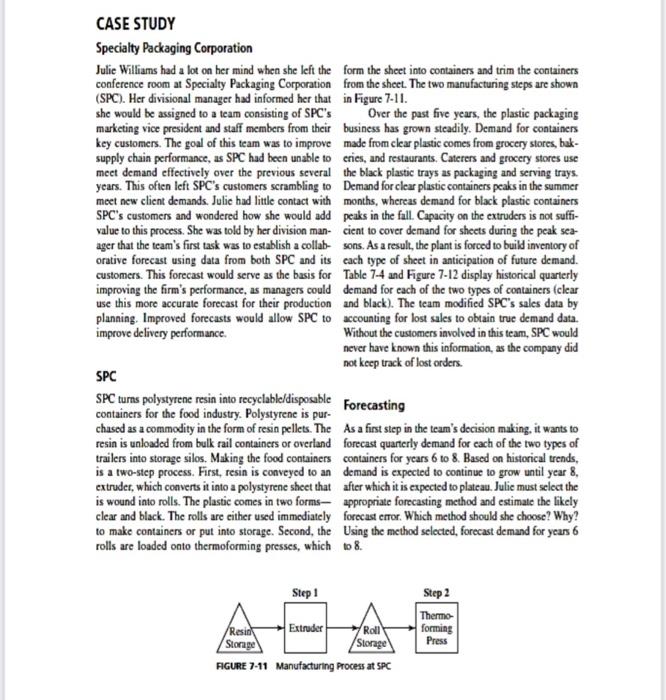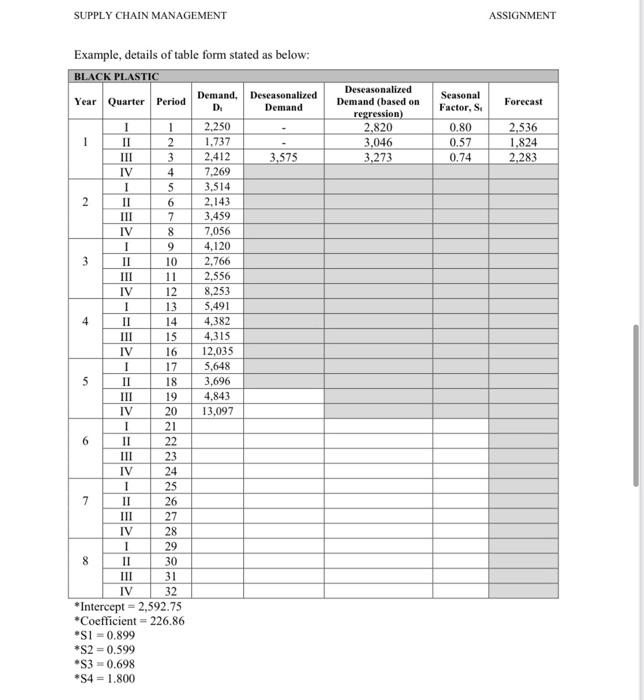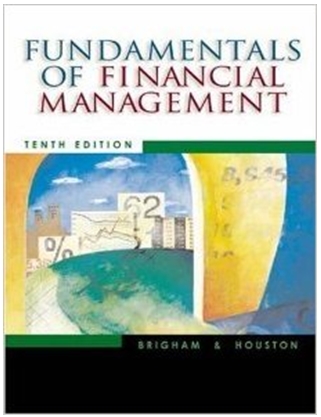Answered step by step
Verified Expert Solution
Question
1 Approved Answer
Hello, please help me to answer my assignment questions on Supply Chain Management. Thank you! QUESTION FOR CASE STUDY 1 (40 MARKS) (SPECIALTY PACKAGING CORPORATION)
Hello, please help me to answer my assignment questions on Supply Chain Management. Thank you! 




QUESTION FOR CASE STUDY 1 (40 MARKS) (SPECIALTY PACKAGING CORPORATION) Quarterly Historical Demand for Clear and Black Plastic Containers Years 1-5 Black Plastic 18000 16000 14000 12000 10000 8000 26000 84000 2000 0 Clear Plastic 1 2 3 4 5 6 7 8 9 10 11 12 13 14 15 16 17 18 19 20 21 Quarter As a first step in the team is decision-making, it wants to forecast quarterly demand for each of the two types of containers for years 6 to 8. Based on historical trends, demand is expected to continue to grow until year 8, after which it is expected to plateau. Julie must select the appropriate forecasting method. Calculate the forecast demand in static method for years 6 to 8. Calculation of static forecasting method must listed in the table form. CASE STUDY Specialty Packaging Corporation Julie Williams had a lot on her mind when she left the form the sheet into containers and trim the containers conference room at Specialty Packaging Corporation from the sheet. The two manufacturing steps are shown (SPC). Her divisional manager had informed her that in Figure 7-11. she would be assigned to a team consisting of SPC's Over the past five years, the plastic packaging marketing vice president and staff members from their business has grown steadily. Demand for containers key customers. The goal of this team was to improve made from clear plastic comes from grocery stores, hak- supply chain performance, as SPC had been unable to cries, and restaurants. Caterers and grocery stores use meet demand effectively over the previous several the black plastic trays as packaging and serving trays. years. This often left SPC's customers scrambling to Demand for clear plastic containers peaks in the summer meet new client demands. Julie had little contact with months, whereas demand for black plastic containers SPC's customers and wondered how she would add peaks in the full. Capacity on the extruders is not suffi- value to this process. She was told by her division man- cient to cover demand for sheets during the peak sea- ager that the team's first task was to establish a collab- sons. As a result, the plant is forced to build inventory of orative forecast using data from both SPC and its each type of sheet in anticipation of future demand. customers. This forecast would serve as the basis for Table 7-4 and Figure 7-12 display historical quarterly improving the firm's performance, as managers could demand for each of the two types of containers (clear use this more accurate forecast for their production and black). The team modified SPC's sales data by planning. Improved forecasts would allow SPC to accounting for lost sales to obtain true demand data. improve delivery performance. Without the customers involved in this team, SPC would never have known this information, as the company did not keep track of lost orders SPC SPC turns polystyrene resin into recyclabledisposable containers for the food industry. Polystyrene is pur- Forecasting chused as a commodity in the form of resin pellets. The As a first step in the team's decision making, it wants to resin is unloaded from bulk rail containers or overland forecast quarterly demand for each of the two types of trailers into storage silos. Making the food containers containers for years 6 to 8. Based on historical trends, is a two-step process. First, tesin is conveyed to an demand is expected to continue to grow until year 8, extruder, which converts it into a polystyrenc sheet that after which it is expected to plateau. Julie must select the is wound into rolls. The plastic comes in two forms appropriate forecasting method and estimate the likely clear and black. The rolls are either used immediately forecast error. Which method should she choose? Why? to make containers or put into storage. Second, the Using the method selected, forecast demand for years 6 rolls are loaded onto thermoforming presses, which to 8 Step 1 Step 2 Thermo forming Press Resin Extruder Roll Storage Storage FIGURE 7-11 Manufacturing Process at SPC SUPPLY CHAIN MANAGEMENT ASSIGNMENT TABLE 7 Quarterly Historical Demand for Clear and Black Plastic Containers Black Plastic Clear Plastic Year Quarter Demand (000 lb) Demand (000 lb) 2.250 3,200 1.737 7,658 2,412 4,420 7,269 2.384 3.514 3,654 2,143 8.680 3.459 5.695 N 7,056 1.953 3 4,120 4.742 2.766 13,673 2.556 6.640 M 8.253 2.737 1 5.491 3.486 11 4,382 13.186 4,315 5,448 N 12,035 3,485 1 5.648 7.728 3.696 16,591 4.843 8.236 N 13,097 3.316 18000 16000 Black Plastic Demand Clear Plastic Demand 14000 12000 10000 Demand 8000 6000 4000 2000 Year 1 Year 2 Year 3 Year 4 Years Year 6 FIGURE 7-12 Plot of Quarterly Demand for clear and Black Plastic Containers SUPPLY CHAIN MANAGEMENT ASSIGNMENT Seasonal Factor, S, Forecast Deseasonalized Demand (based on regression) 2,820 3.046 3,273 0.80 0.57 0.74 2.536 1.824 2.283 Noola : Example, details of table form stated as below: BLACK PLASTIC Demand, Deseasonalized Year Quarter Period D. Demand I 1 2.250 1 II 2 1.737 III 3 2,412 3,575 IV 4 7.269 1 5 3,514 2 6 2.143 III 3,459 IV 7,056 9 4,120 3 II 10 2,766 III 11 2.556 IV 12 8.253 1 13 5,491 4 II 14 4,382 III 15 4,315 IV 16 12,035 1 17 5,648 5 II 18 3,696 III 19 4,843 IV 20 13,097 21 6 22 23 IV 24 1 25 7 II 26 27 IV 28 1 29 8 30 31 IV 32 *Intercept = 2,592.75 *Coefficient - 226.86 S1 -0.899 *S2 = 0.599 S30.698 *S4 = 1.800 5 | = SUPPLY CHAIN MANAGEMENT ASSIGNMENT CLEAR PLASTIC Year Quarter Period Forecast Deseasonalized Demand (based on regression) 3,876 4,140 4,404 Seasonal Factor, St 0.83 1.85 1.00 2.952 7,862 4.175 1 1 II 2 III 3 IV 4 I 5 2 II 6 7 IV 8 I 9 3 II 10 III 11 IV 12 1 13 4 II 14 III 15 IV 16 1 17 5 18 III 19 IV 20 I 21 6 II 22 23 IV 1 25 7 II 26 III 27 IV 28 I 29 8 II 30 31 IV 32 *Intercept = 3.611.98 *Coefficient = 263.94 *SI = 0.762 *S2 = 1.899 *S3 = 0.948 *S4=0.415 Demand, Deseasonalized D. Demand 3,200 7,658 4,420 4.472 2,384 3,654 8,680 5,695 1,953 4,742 13,673 6,640 2.737 3,486 13.186 5,448 3,485 7.728 16,591 8,236 3,316 24 QUESTION FOR CASE STUDY 1 (40 MARKS) (SPECIALTY PACKAGING CORPORATION) Quarterly Historical Demand for Clear and Black Plastic Containers Years 1-5 Black Plastic 18000 16000 14000 12000 10000 8000 26000 84000 2000 0 Clear Plastic 1 2 3 4 5 6 7 8 9 10 11 12 13 14 15 16 17 18 19 20 21 Quarter As a first step in the team is decision-making, it wants to forecast quarterly demand for each of the two types of containers for years 6 to 8. Based on historical trends, demand is expected to continue to grow until year 8, after which it is expected to plateau. Julie must select the appropriate forecasting method. Calculate the forecast demand in static method for years 6 to 8. Calculation of static forecasting method must listed in the table form. CASE STUDY Specialty Packaging Corporation Julie Williams had a lot on her mind when she left the form the sheet into containers and trim the containers conference room at Specialty Packaging Corporation from the sheet. The two manufacturing steps are shown (SPC). Her divisional manager had informed her that in Figure 7-11. she would be assigned to a team consisting of SPC's Over the past five years, the plastic packaging marketing vice president and staff members from their business has grown steadily. Demand for containers key customers. The goal of this team was to improve made from clear plastic comes from grocery stores, hak- supply chain performance, as SPC had been unable to cries, and restaurants. Caterers and grocery stores use meet demand effectively over the previous several the black plastic trays as packaging and serving trays. years. This often left SPC's customers scrambling to Demand for clear plastic containers peaks in the summer meet new client demands. Julie had little contact with months, whereas demand for black plastic containers SPC's customers and wondered how she would add peaks in the full. Capacity on the extruders is not suffi- value to this process. She was told by her division man- cient to cover demand for sheets during the peak sea- ager that the team's first task was to establish a collab- sons. As a result, the plant is forced to build inventory of orative forecast using data from both SPC and its each type of sheet in anticipation of future demand. customers. This forecast would serve as the basis for Table 7-4 and Figure 7-12 display historical quarterly improving the firm's performance, as managers could demand for each of the two types of containers (clear use this more accurate forecast for their production and black). The team modified SPC's sales data by planning. Improved forecasts would allow SPC to accounting for lost sales to obtain true demand data. improve delivery performance. Without the customers involved in this team, SPC would never have known this information, as the company did not keep track of lost orders SPC SPC turns polystyrene resin into recyclabledisposable containers for the food industry. Polystyrene is pur- Forecasting chused as a commodity in the form of resin pellets. The As a first step in the team's decision making, it wants to resin is unloaded from bulk rail containers or overland forecast quarterly demand for each of the two types of trailers into storage silos. Making the food containers containers for years 6 to 8. Based on historical trends, is a two-step process. First, tesin is conveyed to an demand is expected to continue to grow until year 8, extruder, which converts it into a polystyrenc sheet that after which it is expected to plateau. Julie must select the is wound into rolls. The plastic comes in two forms appropriate forecasting method and estimate the likely clear and black. The rolls are either used immediately forecast error. Which method should she choose? Why? to make containers or put into storage. Second, the Using the method selected, forecast demand for years 6 rolls are loaded onto thermoforming presses, which to 8 Step 1 Step 2 Thermo forming Press Resin Extruder Roll Storage Storage FIGURE 7-11 Manufacturing Process at SPC SUPPLY CHAIN MANAGEMENT ASSIGNMENT TABLE 7 Quarterly Historical Demand for Clear and Black Plastic Containers Black Plastic Clear Plastic Year Quarter Demand (000 lb) Demand (000 lb) 2.250 3,200 1.737 7,658 2,412 4,420 7,269 2.384 3.514 3,654 2,143 8.680 3.459 5.695 N 7,056 1.953 3 4,120 4.742 2.766 13,673 2.556 6.640 M 8.253 2.737 1 5.491 3.486 11 4,382 13.186 4,315 5,448 N 12,035 3,485 1 5.648 7.728 3.696 16,591 4.843 8.236 N 13,097 3.316 18000 16000 Black Plastic Demand Clear Plastic Demand 14000 12000 10000 Demand 8000 6000 4000 2000 Year 1 Year 2 Year 3 Year 4 Years Year 6 FIGURE 7-12 Plot of Quarterly Demand for clear and Black Plastic Containers SUPPLY CHAIN MANAGEMENT ASSIGNMENT Seasonal Factor, S, Forecast Deseasonalized Demand (based on regression) 2,820 3.046 3,273 0.80 0.57 0.74 2.536 1.824 2.283 Noola : Example, details of table form stated as below: BLACK PLASTIC Demand, Deseasonalized Year Quarter Period D. Demand I 1 2.250 1 II 2 1.737 III 3 2,412 3,575 IV 4 7.269 1 5 3,514 2 6 2.143 III 3,459 IV 7,056 9 4,120 3 II 10 2,766 III 11 2.556 IV 12 8.253 1 13 5,491 4 II 14 4,382 III 15 4,315 IV 16 12,035 1 17 5,648 5 II 18 3,696 III 19 4,843 IV 20 13,097 21 6 22 23 IV 24 1 25 7 II 26 27 IV 28 1 29 8 30 31 IV 32 *Intercept = 2,592.75 *Coefficient - 226.86 S1 -0.899 *S2 = 0.599 S30.698 *S4 = 1.800 5 | = SUPPLY CHAIN MANAGEMENT ASSIGNMENT CLEAR PLASTIC Year Quarter Period Forecast Deseasonalized Demand (based on regression) 3,876 4,140 4,404 Seasonal Factor, St 0.83 1.85 1.00 2.952 7,862 4.175 1 1 II 2 III 3 IV 4 I 5 2 II 6 7 IV 8 I 9 3 II 10 III 11 IV 12 1 13 4 II 14 III 15 IV 16 1 17 5 18 III 19 IV 20 I 21 6 II 22 23 IV 1 25 7 II 26 III 27 IV 28 I 29 8 II 30 31 IV 32 *Intercept = 3.611.98 *Coefficient = 263.94 *SI = 0.762 *S2 = 1.899 *S3 = 0.948 *S4=0.415 Demand, Deseasonalized D. Demand 3,200 7,658 4,420 4.472 2,384 3,654 8,680 5,695 1,953 4,742 13,673 6,640 2.737 3,486 13.186 5,448 3,485 7.728 16,591 8,236 3,316 24 




Step by Step Solution
There are 3 Steps involved in it
Step: 1

Get Instant Access to Expert-Tailored Solutions
See step-by-step solutions with expert insights and AI powered tools for academic success
Step: 2

Step: 3

Ace Your Homework with AI
Get the answers you need in no time with our AI-driven, step-by-step assistance
Get Started


